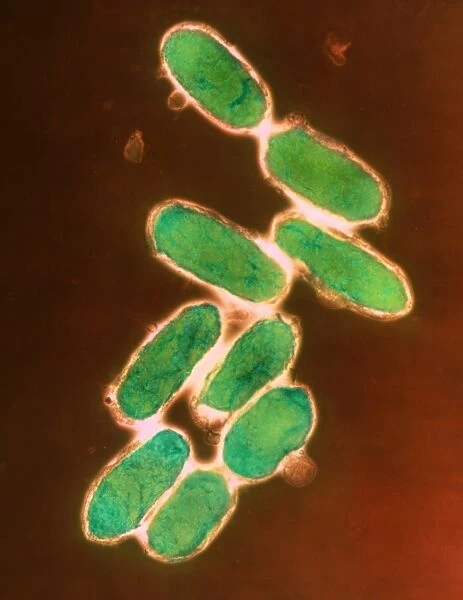Yersinia pestis (plague) bacteria
![]()

Wall Art and Photo Gifts from Science Photo Library
Yersinia pestis (plague) bacteria
False-colour transmission electron micrograph of Yersinia pestis, the bacterium which causes bubonic plague (the Black Death of the Middle Ages). The bacterium is primarily a flea-carried pathogen of rats. Transfer to man occurs when a flea is obliged to leave its dead rodent host and feed on human blood. Infection is rapid, causing swellings in the lymph nodes (buboes) and leading to septicaemia & pulmonary infection. Extensive control measures, directed against the rats as well as their fleas, have essentially banished the plague from Europe, but there are still many regions of the world where the disease occurs. Magnification:x24, 000 at 8x10inch, x6, 857 at 6x7cm
Science Photo Library features Science and Medical images including photos and illustrations
Media ID 6284870
© A. DOWSETT, HEALTH PROTECTION AGENCY/SCIENCE PHOTO LIBRARY
Bacteria Bacterial Bacteriology Bacterium Bacterium Causing Black Death Bubonic Plague Cause Of Electron Micrograph Micro Organisms Microbe Microbes Plague Pneumonic Plague Septcemic Plague Transmission Yersinia Pestis False Coloured Micro Biology
EDITORS COMMENTS
This print showcases the Yersinia pestis bacteria, responsible for the devastating bubonic plague, also known as the Black Death during the Middle Ages. In this false-colour transmission electron micrograph, we get a glimpse into the intricate world of these tiny microbes. Yersinia pestis primarily thrives in fleas that infest rats, acting as carriers of this deadly pathogen. When a flea is forced to abandon its deceased rodent host and seek sustenance from human blood, it transfers the infection rapidly. The consequences are dire: lymph nodes swell up with painful buboes while septicaemia and pulmonary infections take hold. Although extensive control measures have successfully eradicated the plague from Europe by targeting both rats and their fleas, several regions around the world still grapple with this menacing disease. The magnification at which this image was captured is truly remarkable - x24,000 at 8x10 inches or x6,857 at 6x7cm - allowing us to appreciate every minute detail of these bacterial invaders through advanced transmission electron microscopy (TEM). This photograph serves as a reminder of our ongoing battle against infectious diseases and highlights how scientific advancements continue to shed light on microscopic organisms that shape our history and health.
MADE IN THE UK
Safe Shipping with 30 Day Money Back Guarantee
FREE PERSONALISATION*
We are proud to offer a range of customisation features including Personalised Captions, Color Filters and Picture Zoom Tools
SECURE PAYMENTS
We happily accept a wide range of payment options so you can pay for the things you need in the way that is most convenient for you
* Options may vary by product and licensing agreement. Zoomed Pictures can be adjusted in the Basket.


